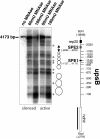Alterations in local chromatin environment are involved in silencing and activation of subtelomeric var genes in Plasmodium falciparum
- PMID: 17725559
- PMCID: PMC2169929
- DOI: 10.1111/j.1365-2958.2007.05899.x
Alterations in local chromatin environment are involved in silencing and activation of subtelomeric var genes in Plasmodium falciparum
Abstract
Plasmodium falciparum erythrocyte membrane protein 1 (PfEMP1), encoded by the var gene family, undergoes antigenic variation and plays an important role in chronic infection and severe malaria. Only a single var gene is transcribed per parasite, and epigenetic control mechanisms are fundamental in this strategy of mutually exclusive transcription. We show that subtelomeric upsB var gene promoters carried on episomes are silenced by default, and that promoter activation is sufficient to silence all other family members. However, they are active by default when placed downstream of a second active var promoter, underscoring the significance of local chromatin environment and nuclear compartmentalization in var promoter regulation. Native chromatin covering the SPE2-repeat array in upsB promoters is resistant to nuclease digestion, and insertion of these regulatory elements into a heterologous promoter causes local alterations in nucleosomal organization and promoter repression. Our findings suggest a common logic underlying the transcriptional control of all var genes, and have important implications for our understanding of the epigenetic processes involved in the regulation of this major virulence gene family.
Figures






Similar articles
-
Analysis of subtelomeric virulence gene families in Plasmodium falciparum by comparative transcriptional profiling.Mol Microbiol. 2012 Apr;84(2):243-59. doi: 10.1111/j.1365-2958.2012.08019.x. Epub 2012 Mar 22. Mol Microbiol. 2012. PMID: 22435676 Free PMC article.
-
Active transcription is required for maintenance of epigenetic memory in the malaria parasite Plasmodium falciparum.J Mol Biol. 2008 Oct 3;382(2):288-97. doi: 10.1016/j.jmb.2008.07.015. Epub 2008 Jul 16. J Mol Biol. 2008. PMID: 18656490 Free PMC article.
-
A var gene promoter controls allelic exclusion of virulence genes in Plasmodium falciparum malaria.Nature. 2006 Feb 23;439(7079):1004-8. doi: 10.1038/nature04407. Epub 2005 Dec 28. Nature. 2006. PMID: 16382237
-
Plasmodium falciparum: epigenetic control of var gene regulation and disease.Subcell Biochem. 2013;61:659-82. doi: 10.1007/978-94-007-4525-4_28. Subcell Biochem. 2013. PMID: 23150271 Review.
-
Antigenic variation in Plasmodium falciparum.Annu Rev Microbiol. 2008;62:445-70. doi: 10.1146/annurev.micro.61.080706.093134. Annu Rev Microbiol. 2008. PMID: 18785843 Review.
Cited by
-
Identification of a cis-acting DNA-protein interaction implicated in singular var gene choice in Plasmodium falciparum.Cell Microbiol. 2012 Dec;14(12):1836-48. doi: 10.1111/cmi.12004. Epub 2012 Sep 4. Cell Microbiol. 2012. PMID: 22891919 Free PMC article.
-
Frequent recombination events generate diversity within the multi-copy variant antigen gene families of Plasmodium falciparum.Int J Parasitol. 2008 Aug;38(10):1099-109. doi: 10.1016/j.ijpara.2008.01.010. Epub 2008 Feb 29. Int J Parasitol. 2008. PMID: 18395207 Free PMC article.
-
Targets of antibodies against Plasmodium falciparum-infected erythrocytes in malaria immunity.J Clin Invest. 2012 Sep;122(9):3227-38. doi: 10.1172/JCI62182. Epub 2012 Aug 1. J Clin Invest. 2012. PMID: 22850879 Free PMC article.
-
A major role for the Plasmodium falciparum ApiAP2 protein PfSIP2 in chromosome end biology.PLoS Pathog. 2010 Feb 26;6(2):e1000784. doi: 10.1371/journal.ppat.1000784. PLoS Pathog. 2010. PMID: 20195509 Free PMC article.
-
A global transcriptional analysis of Plasmodium falciparum malaria reveals a novel family of telomere-associated lncRNAs.Genome Biol. 2011 Jun 20;12(6):R56. doi: 10.1186/gb-2011-12-6-r56. Genome Biol. 2011. PMID: 21689454 Free PMC article.
References
-
- Al-Khedery B, Allred DR. Antigenic variation in Babesia bovis occurs through segmental gene conversion of the ves multigene family, within a bidirectional locus of active transcription. Mol Microbiol. 2006;59:402–414. - PubMed
-
- Andrulis ED, Neiman AM, Zappulla DC, Sternglanz R. Perinuclear localization of chromatin facilitates transcriptional silencing. Nature. 1998;394:592–595. - PubMed
-
- Baruch DI, Pasloske BL, Singh HB, Bi X, Ma XC, Feldman M, et al. Cloning the P. falciparum gene encoding PfEMP1, a malarial variant antigen and adherence receptor on the surface of parasitized human erythrocytes. Cell. 1995;82:77–87. - PubMed
-
- Beeson JG, Duffy PE. The immunology and pathogenesis of malaria during pregnancy. Curr Top Microbiol Immunol. 2005;297:187–227. - PubMed
Publication types
MeSH terms
Substances
Grants and funding
LinkOut - more resources
Full Text Sources
Research Materials

